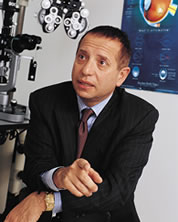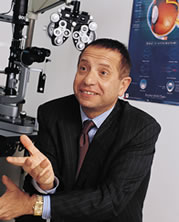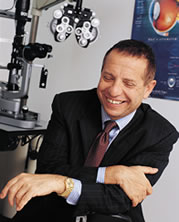|
 JL Miami is very different from Boston.
Why did you decide to come here?
JL Miami is very different from Boston.
Why did you decide to come here?
CP It is indeed
very different. The main difference that strikes you immediately is
that in Massachusetts everything is old. Very old. Here, everything
is new. Very new.
I took the job here for one reason: I think
Bascom Palmer is the best department of ophthalmology in the world.
The faculty here has contributed more to the field of ophthalmology
than anyone else, period, and the facilities and financial resources
are tremendous. The bottom line is that Bascom Palmer is a big and very
complicated place to run, and anyone would have to be practically insane
to take on the challenge. I figured I was qualified!
JL Now that you’re
here, what are your first impressions of Bascom Palmer?
CP One of the first
things that struck me is that it is a huge institution with really interesting
patients. That’s a challenge and an opportunity. There are definitely
some rough spots, and the place has had a little bit of a jangling kind
of personality. One of the biggest challenges I face is that, for so
many years, Bascom Palmer was run like a family business, and I need
to help advance it to the next level.
What impresses me most is that the critical
resources at Bascom Palmer are tremendous. You need three things for
battle or for business: leadership, commitment, and firepower. We certainly
have the commitment from our faculty, the staff, and the dean; that’s
without question. And Bascom Palmer most definitely has the firepower;
our endowment is fairly rich. But we need leadership, and I intend to
provide that.
JL What makes Bascom
Palmer special?
CP Bascom Palmer is
one of the top eye centers in the world—without question. For instance,
we have eight of the world’s best glaucoma clinicians, which makes
us extremely strong on the clinical side. But I’m also interested
in promoting and developing more eye research. In terms of research,
we need to rebuild. Our basic research faculty must complement our stellar
clinical faculty. It’s a logical complement.
At Bascom Palmer we have the best of all worlds
when it comes to patients. We have great balance, a good mix. We have
a large and loyal private patient base, and we see a significant number
of unfunded patients. We also are blessed with a large international
clientele. About 15 percent of our patient base is international. That’s
phenomenal.
We serve all of our patients very well. In
Miami-Dade County there’s absolutely no reason for anyone to suffer
from untreated eye disease or blindness. No reason whatsoever.
JL You had a long
and successful tenure at the New England Eye Center. How did that evolve?
CP I had been
at Harvard my entire career—Harvard College, Harvard Medical School.
But a handful of us went down the street, literally, and found we could
do something more. We created the New England Eye Center, and I discovered
I could do something very different that I enjoyed immensely. I had
ten wonderful years there that will never be replicated.
JL And Bascom Palmer
seemed like a natural follow-up to that?
CP Bascom Palmer was
created in much the same spirit as the New England Eye Center. But there
is no story like Bascom Palmer’s in all of the history of ophthalmology.
This place is legendary. This was my destiny.
JL Why did you choose
ophthalmology as a profession?
CP I really like ophthalmology.
As a matter of fact, I thoroughly enjoy it. It’s a great subspecialty.
I like the patient care aspects as well as the research components.
Besides, ophthalmologists are really smart people, and I like hanging
out with them.
JL In my first meeting
with you, you warned me that you could be my worst nightmare—someone
with an M.D. and an M.B.A. Why did you go for an M.B.A.?
CP In the mid-1990s
I watched some very ugly things happen at hospitals in Boston, all kinds
of cost-cutting and reimbursement issues. I remember thinking that there
must be a smarter way to do this, a smarter way to run these businesses.
And make no mistake, health care is a huge business. So I decided to
enroll in the executive M.B.A. program at Wharton, commuting between
Boston and Philadelphia on weekends. Wharton is a very New York finance-oriented
business school, but it also has a long-standing health management program.
And although I was in the general M.B.A. program, the faculty there
liked for doctors to get a strong dose of management.
JL How have you found
the M.B.A. helpful?
CP In my current job,
that training is invaluable to understand the complex relationships
that exist on every level—from general accounting to strategic
planning. The M.B.A. gives you a toolbox of stuff that you can use.
You simply choose the right tool for the right job.
JL What trends are
emerging in ophthalmology? What does the immediate future hold for your
profession?
CP There are two things
that patients fear most. One is cancer; the other is blindness. Eye
diseases are going to be pervasive in the 21st century because they’re
chronic diseases of older people. There will be a doubling of the population
over the age of 65 in the next 30 years. All the doctors being trained
today are going to be looking at a world in which very common eye diseases
are even more prevalent than they are now—diseases like macular
degeneration and glaucoma. For instance, we have one faculty member
who is in the process of writing an NIH grant to look at the epidemiology
of the prevalence of age-related eye diseases, with Miami-Dade County
as our laboratory. The payoff will be a huge yield in terms of improved
quality of life for our older citizens.
JL It’s sometimes
hard to show measurable strides at an institution that is already established
and has a good reputation. How will you make a noticeable difference
at Bascom Palmer?
CP I think one area,
for sure, will be that I intend to focus heavily on the public health
aspects of eye disease. We’re going to outreach aggressively from
this organization, on a lot of different levels. And public health research
will be high on the agenda. We will study eye diseases in our general
population as well as in the Hispanic and African-American populations.
There are a lot of interesting things that can be done here.
Access
also is something I think I can improve. Because we are the only academic
medical center for five million people, we have the challenge of making
it possible for five million people to access us. We must improve access
for patients so we maintain our value to them.
And
finally, we absolutely must focus more on patient satisfaction at Bascom
Palmer and at Anne Bates Leach Eye Hospital. We definitely need to give
a facelift to our customer service programs, focusing not on what’s
best for doctors and employees, but what’s best for our patients.
|



 JL
JL